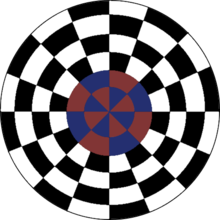Storilljuðjorrayc
| This page is a work in progress by its author(s) and should not be considered final. |
 Storilljuðjorrayc board | |
| Genre(s) |
Board game Abstract strategy game |
|---|---|
| Players | 2 |
| Setup time | < 1 minute |
| Playing time | Varies |
| Random chance | None |
| Skill(s) | strategy, tactics |
| Other names | Redentran Chess |
Storilljuðjorrayc (/sto-ri-luð-jor-ratʃ/), sometimes spelled Storilljudhjorrayc, also called Redentran chess or Xtol Unorgja, is a strategy board game for two players that originated from the Zdelmyor tribes in present-day Redentro. The game is one of the most popular board games in Redentro, with nationally televised tournaments and league matches.
The game represents a clearing battle between two armies, with the object of capturing the enemy's king and warmaster. Distinctive features of storilljuðjorrayc include the artillery, which attack from a distance; areas called the focus and the forest, which restrict the movement of some pieces; and the round board.
Board
Storilljuðjorrayc is played on a round board consisting of six concentric rings. The outer four rings are called the clearing (rm: jinter, zd: jinte), and consist of sixteen spaces each. The inner two rings are called the focus (rm: erdiklanu, zd: motdinar), and consist of only eight spaces each. There is also a third region outside of the board known as the forest (rm: vosk, zd: foska).
The rings are called circuits (rm: rondaþ, zd: varunar), while the axes running out from the center of the board are called radials or radii (rm: altenaþ, zd: altena). Movement along a circuit is called tangential, and movement along a radius is called radial. All spaces in the inner ring are considered radially adjacent, except those that are tangentially adjacent. Movement between spaces that touch on a corner (except across the inner ring) is called diagonal.
Rules
Unlike most classical strategy games, players may set up their pieces in any arrangement they wish on certain spaces of the board. All pieces (with the exception of the ambush) must start within these spaces, shown on the board at left. It is left unspecified whether purple (South) or green (North) plays first, so it is left to the players or the house or tournament rules which player goes first.
Each player in turn completes one of three actions: moving, attacking, or passing. If a player moves, then any single piece (or both lords) may be moved according to that piece's movement rules. If a player attacks, then any single piece may attack an enemy piece (or multiple pieces in the case of archers) according to that piece's attack rules. If a player passes, their turn ends without moving or attacking. Unlike chess, pieces cannot attack and move in the same turn, except for the ambush.
The game ends when one player has captured both the king and the warmaster of his or her opponent. Unlike chess, no warning is required when either of these pieces are in danger of capture. They are simply captured as normal pieces.
Pieces
The two players' pieces are usually colored green and purple. Pieces are flat circular discs labeled or engraved with one or two Latin letters or Arabic numerals (in most modern sets) or Zdelmyor unit characters or a set of dots.



